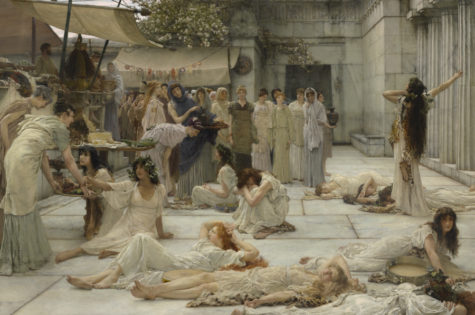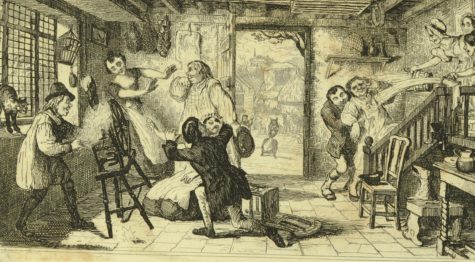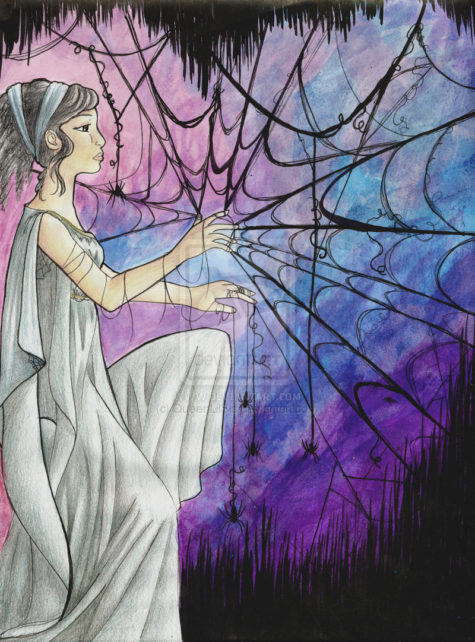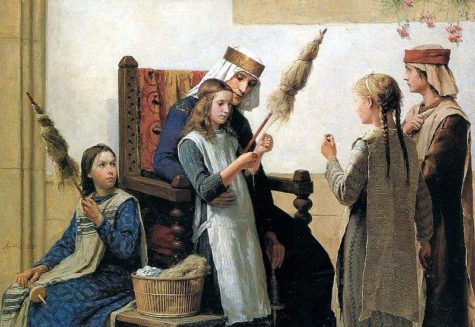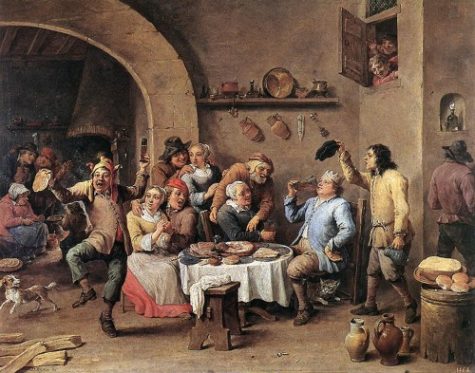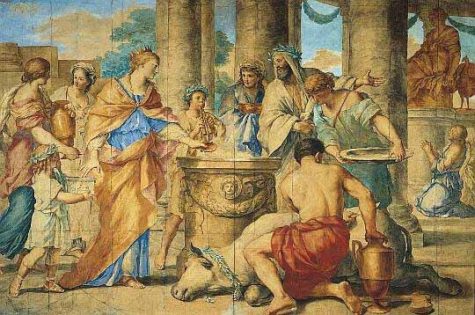January
At dusk on January 8th, the Haloa (῾Αλῶα) starts. Haloa took place every year, during the month Poseideon (Ποσειδέωνας), after the first harvest was over. The festival took place around the threshing floor (αλώνια) at the same time throughout Attica. At Eleusis there was a festival called Haloea on the 26th of the month Poseideon.
All women were expected to attend this event, but men were almost always excluded. Interestingly enough, men had a legal and moral expectation to pay for their wives’ expenses in these festivities. The strange timing of the harvest festival—mid-winter—is significant as well.
The Haloea, a festival for Demeter and Dionysus, included a procession for Poseidon. The Haloea is thought to have been a time for merriment. There is mention of a women’s rite in connection with this holiday: Women are provided with wine and food, including cakes in the shapes of sexual organs. They withdraw to themselves and “exchange scurrilous banter, and are teased with suggestions of promiscuity whispered in their ears by ‘the priestesses’.” The women are thought to have stayed secluded throughout the night and then to have joined the men the next day. While the women were off eating, drinking, and sounding much like the women of Lysistrata, the men are thought to have created a big pyre or a bunch of little bonfires.
The Greeks regarded the festival as sacred to not only Demeter but also to Dionysus. With the inclusion of Dionysus in the festival worship, the date shifted towards the winter as “he possessed himself of the festivals of Demeter, took over her threshing-floor and compelled the anomaly of a winter threshing festival.” In many ways, the festival was just as connected, if not more so, with Dionysus than with Demeter. Thus, we see the power and influence of the incoming god and of the importance of wine to Greek cult activity. Practically, Greeks were able to coax out a harvest just early enough to revel with Dionysus.
Despite being among the most documented of Greek festivals, very few records of what exactly occurred during Haloa. Because it was a predominantly, if not exclusively, women’s festival, little information has survived, or was recorded at all, about its characteristics and rituals. In fact, one of the most detailed sources of Haloa actually consists of marginal notes from the 13th century AD on the Roman writer Lucian’s works.
According to these notes, the women’s ritual practices involved “pits, snakes, pigs, and models of genitalia, all of which have a more or less marked sexual significance.” We also know that the festival “is said to have comprised Mysteries of Demeter, Kore, and Dionysus.” Another source singled out these women’s festivals as “containing the germ of ‘Mysteries,’” referencing here the Eleusinian Mysteries—annual initiation ceremonies devoted to the cult of Demeter and Persephone.
Celebrating Haloa
In the earliest times the religious part of the festival might have been restricted to married women, but after the fourth century BCE its celebration may have been limited to hetairai (ἑταῖραι, female companions, a term used non-sexually for women, about women, but used by men to indicate a woman hired for entertainment, often leading to sex), or they were simply also allowed to hold their own symposium during the Haloa, either at home or at Eleusis. The Haloa would have been the day on which they were initiated into the Mysteries. The Eleusinian Arkhontes (Ἄρχοντες, male magistrates of the Mysteries) prepared a huge banquet on this day, with a huge variety, including phallus- and vagina-shaped cakes, but not foods forbidden in the Mysteries: pomegranates, apples, eggs, fowls, some types of fish were out. Animal sacrifice was also disallowed on this day: Demeter received offerings of fresh fruit.
After preparing the food, the Arkhontes left, leaving the women to eat, to drink lots and lots of wine, and to celebrate being a woman and fertile (or the wish to be fertile). The Arkhontes went to the men who were waiting outside of Eleusis for their part in the Mysteries, and told them the story of Eleusis, and how the Eleusinians had discovered nourishment for the entire human race. A giant phallus is often assumed to have been set up on the hálōs, and the women would dance around it carrying clay models of phalli and vaginas, but it is more likely the phallus was never there, but depicted on art work about the Haloa to indicate the fertility aspects of the festival and the dances that occurred there. As part of the festivities, the women engaged in sexualized conversation with each other. As part of the sacrifice, the women carried kernoi (κέρνοι, offering dishes) on their heads, containing incense, grains or other offerings, which they tipped onto the giant phallus or, and this is probably far more accurate, onto the altar.
After the feast and sacrifice, the men who had been waiting were admitted to the grounds, and the women were encouraged by each other–including the priestesses–to take secret lovers for the night. A priest and priestess–with torches representing Demeter and Persephone–apparently sat watch on chests as they presided over the fertility celebration.
To Do Today:
The Haloa is the perfect time to organize an adult ‘girl’s night’ with your closest female friends. Watch a movie with erotic tones, drink wine together, gorge yourselves on chocolate and gossip about your partners. If you have an agreement about it with your partner, you could find a lover for the night. If not, go home to him or her and spend the night together in your own ‘fertility rite’. If you’re single and have no one to fill your bed… well… a girl can get creative, can’t she?
For the men, the Haloa might have had an extra ritual part as well; honoring Poseidon as an agricultural Theos. There is evidence that the men built a huge bonfire and had their own conversations around it. Afterwards, they joined the women, when possible (and desired). Single men; I’m sure you can be as creative as the single women reading this.
It’s Distaff’s Day (Jan 7th) and time to get back to work after the holidays. (According to Old English tradition, that is.) A distaff is the wooden rod (staff) that holds the flax or wool on a spinning wheel. The term distaff came to refer to both women’s work and the female branch (distaff side) of the family. The women’s husbands did not go back to work until the following Monday (see below), so they would mischievously try to set fire to the flax on their wives’ distaffs, while the women, lying in wait, would douse them with buckets of water.
From Chambers Book of Days, we have this explanation:
As the first free day after the twelve by which Christmas was formerly celebrated, the 7th of January was a notable one among our ancestors. They jocularly called it St. Distaff’s Dag, or Rock Dag, because by women the rock or distaff was then resumed, or proposed to be so. The duty seems to have been considered a dubious one, and when it was complied with, the ploughmen, who on their part scarcely felt called upon on this day to resume work, made it their sport to set the flax a-burning; in requital of which prank, the maids soused the men from the water-pails.
“Partly work and partly play.
Ye must on Saint Distaff’s day;
From the plough soon free the team,
Then come home and fother them;
If the maid a spinning goe,
Burn the flax and fire the towe,
Bring in pails of water then
Let the maids bewash the menne;
Give Saint Distaff all the right
Then bid Christmas sports good-night,
And next morrow every one.
To his own vocation.”
This is an excellent day for spells involving sewing, weaving, mending, and also for practical jokes and family fun.
A Ritual for St Distaff Day:
From the book, 365 Goddess, we have some nice ideas for how to celebrate St. Distaff day in a magickal way:
- Themes: Work, Weaving, Destiny
- Symbols: Web, Spinning Wheel, Needle
Presiding Goddess:
Arachne, the Greek spider goddess, inspires positive changes in your destiny for the new year. Legend tells us that Arachne challenged Athena to a weaving contest and won. In anger, Athena destroyed the girl’s tapestry. Arachne, grief-stricken, took her destiny in hand and turned herself into a spider, but she continues to use her weaving talents to spin and pattern the lives of mortals.
To do today:
According to lore, Saint Distaff, the patroness of weaving, was a fictional persona made up to mark the resumption of normal activity after the holidays. Instead of this imaginary figure, we turn to Arachne to help us take the strands of our fate in hand and begin weaving a year filled with goddess energy.
To direct your spiritual focus toward the goddess, wear something woven today, or display it proudly. If you have no such items, braid together three strands of thread or yarn, saying:
Arachne, bless this magic braid,
so on you my mind is staid.
Carry this as a charm to keep your thoughts and actions goddess-centered.
Finally, mend any work clothes in need or repairs to improve your job standing. As you make the final knot in a button or hem, bind the magic by saying:
This thread I wind,
The magic bind.
Visualize your professional goals as you work.
More about St. Distaff Day:
St. Distaff’s Day had no connection whatsoever with any saint but its place in the folk calendar gives an indicator of the importance of spinning at a time when this was the only means of turning the raw wool, cotton or flax into thread capable of being woven into cloth.
The day, which was also known as Rock Day (referring to another name for either the distaff or the spindle) indicated that this was the end of the Christmas festivities and the return to the normality of spinning whenever there was a spare moment.
As Anthony Fitzherbert, wrote in his ‘Boke of Husbandrie’ (1523):
it saveth a woman from being idle,
and the product was needful’.
Before the invention of the Spinning Wheel, spinning on what is known as the Drop Spindle (a pin or stick weighted by a whorl) was a slow and tedious task. The spinning of one pound of woolen yarn could take about one week and one pound of heavy cotton yarn several weeks to spin.
The method had not changed since the earliest times. There are images from as far back as time of the Ancient Egyptians showing how the distaff was used to hang the flax or tow and the spindle to effect the twisting. The distaff was carried under the arm, and the spindle left dangling and turning in the fingers below, and forming an axis round which to wind parcels of the thread as soon as it was made.
Women of all classes would spin. Everyone from the Lady to the peasant was expected to spend time on the task, though the wealthier may have elaborate spindles. In the evening, after the chores of the day were done, there would be spinning, and the spindle would be taken to visit friends as the task could be undertaken at the same time as a conversation.
Source: Telling History
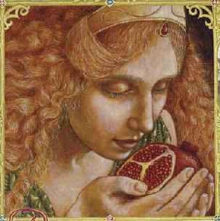 Themes: Luck, Cycles, Youthful Energy
Themes: Luck, Cycles, Youthful Energy
Symbols: Coins, Corn, the number 7, Flower Buds, Pomegranate
About Kore: An aspect of Persephone before her marriage to Hades, this youthful goddess motivates good fortune, zeal, and a closer affinity to earth’s cycles during the coming months.
Kore, whose name means “maiden,” is the youngest aspect of the triple goddess. She was the daughter of Zeus and Demeter, as beautiful as spring’s blossoms and as fragrant as its breezes. It was this beauty that inspired Hades to tempt her with a pomegranate, a symbol of eternal marriage. Because she ate the fruit, Persephone spends winter with Hades as his wife and returns to the earth in spring.
To Do Today (Jan 5 or 6): Traditionally, on this day the Greeks carried an image of Kore around the temple seven times for victory, protection, and good fortune. Since your home is your sacred space, consider walking clockwise around it seven times with any goddess symbol you have (a round stone, vase, or bowl will suffice). As you go, visualize every nook and cranny being filled with the yellow-white light of dawn, neatly chasing away any lingering winter blues.
This day marks winter’s passage and perpetuates Kore’s gusto and luck in your home year-round. Also consider carrying a little unpopped popcorn in your pocket to keep Kore’s zeal and vigor close by for when you need it.
Other Rites of Kore: Epiphanius (fourth century), gives an account of a rite held at Alexandria on the night of January 5-6.
In the temple of Kore – the Maiden (Persephone) – he tells us, worshipers spent the night in singing and flute-playing, and at cockcrow brought up from a subterranean sanctuary a wooden image seated naked on a litter. It had the sign of the cross upon in gold in five places – the forehead, the hands, and the knees. This image was carried seven times round the central hall of the temple with flute-playing, drumming, and hymns. It was said: “To-day, at this hour, hath Kore (the Maiden) borne the Aeon.” The image was then taken back to the underground chamber.
Courtesy of: 365 Goddess and other sources
In Old England, The Twelfth Night marked the end of the winter festival that started on Samhain. The Lord of Misrule symbolizes the world turning upside down with the coming of winter. In the middle ages, the Twelfth Night began on the eve of December 25th moving forward 12 days to January 6th, hence the name the twelve days of Christmas.
The Twelfth Night festival marked the onset of the winter solstice, the point in late December when the sun, whose daily arc had reached its lowest, darkest, coldest point, began its rise toward the longer, warmer days and the coming of spring. On December 25th, the ceremonial Yule log was hauled in to start the hearth fire around which its members and visitors would gather throughout the rest of the Christmas festival days.
Twelfth Night was the final frenzy of feasting, drinking and merry making before the townspeople returned to daily life for the remainder of winter. A grand cake was the focus of the celebratory feast as well as Wassail, Fig Pudding and other generous tasty handmade dishes.
In the ancient times of the Roman Saturnalia, the “king of the feast” was elected by beans, and the Twelfth Night cakes included a bean–or, later, a ring or coin. Whoever was given the slice with the prize became the queen and king for the night and much parading and merriment followed.
In the church calendar, Twelfth Night is the evening before Epiphany (January 6). Because the three wise men (or kings) arrived in Bethlehem bearing gifts for the infant Jesus, Epiphany is also called Three Kings Day and a traditional time of gift giving.
Sources: White Magick Alchemy and Almanac.com
The eleventh day of Christmas (Jan 4th) is Evergreen Day. An evergreen tree is a tree that has leaves in all seasons. This contrasts with deciduous trees which completely lose their foliage during the winter or dry season.
The term “evergreen” can refer metaphorically to something that is continuously renewed or is self-renewing. One example of metaphorical use of the expression is the term “Evergreen content” used to describe perennial articles or guides about topics that do not change frequently.
On the Internet, evergreen is a term used by some ad agencies to describe a Web site that is updated on a daily or other frequent basis. A Web site that is evergreen is considered more likely to attract both first-time and repeat visitors.
In magick, evergreens are considered to have a cleansing, and revitalizing power. The aroma of evergreen trees reinvigorates and replenishes psychic and magical energy.
The tenth day of Christmas (Jan 3) is Snow Day. On this day we pay our respects to snow. No depiction of Christmas and Midwinter celebration is complete without it. Snow has so many qualities and so many aspects that it is not surprising that the Inuit people have literally hundreds of words that describe its variety of colors and texture.
So today let us devote ourselves to the contemplation and honoring of the million small crystals that drift across the lands of the Northern hemisphere at this time of the year. And, if we have no snow to look at and celebrate, let us at least remember it in all its fine whiteness, cancelling out the darkness of Midwinter and transforming even the grayest and bleakest of scenes into a place of magic.
Source: The Winter Solstice
 According to Scottish custom, the first Monday of the new year was the time to give children and servants a small gift, or handsel. Literally something given into the hands of someone else, the gift itself was less important than the good luck it signified. The handsel was popular as a new year’s gift from the 14th to 19th centuries, but it also had a broader application to mark any new situation. It continues today in the form of a housewarming gift to someone moving into a new home.
According to Scottish custom, the first Monday of the new year was the time to give children and servants a small gift, or handsel. Literally something given into the hands of someone else, the gift itself was less important than the good luck it signified. The handsel was popular as a new year’s gift from the 14th to 19th centuries, but it also had a broader application to mark any new situation. It continues today in the form of a housewarming gift to someone moving into a new home.
Source: Almanac.com
The Kalends of January (Jan 2nd, the 9th day of Christmas) was a significant part of the Roman Midwinter celebrations, and has lent its name to Midwinter festivals all over the Western world. For example, in Provence in France the festival is known as Calendas, in Poland it is called Kolenda, and in Russia, Kolyada. In the Czech Republic it is called Koteda, in Lithuania, Kalledos, and in Wales and Scotland, Calenig and Calluinn respectively – all these names derived from the Latin Kalendae, and all referring to the festival of midwinter.
Initially the Kalends followed Saturnalia, beginning a few days of rest to allow aching heads and stomachs to recover! At this time new consuls were inducted into office, and for at least three days a high festival took place.
Houses were decorated with lights and greenery and gifts were exchanged. It was also the custom to give special presents to the emperor. These, called Votae, were left in the porch of the imperial palace, and it is recorded that the Emperor Calligula not only demanded these gifts from everyone, but also stood in the porch to collect them personally!
It may have been the memory of this that prompted the 4th century writer Libanius to describe the festival in terms that might be easily applied to the modern celebration of Christmas as to the celebrations in ancient Rome:
The impulse to spend seizes everyone..
People are not only generous themselves,
but also towards their fellow men.
A stream of presents pours itself out on all sides.
The Kalends festival banishes all that is
connected with toil, and allows men to give
themselves up to undisturbed enjoyment.
From the minds of young people it
removes two kinds of dread:
the dread of the schoolmaster and
the dread of the pedagogue.
The slave also it allows, as far as possible,
to breathe the air of freedom…
Another great quality of the festival
is that it teaches men not to hold too fast
to their money, but to part with it
and let it pass into other hands.
Source: The Winter Solstice
What follows is a list (in alphabetical order) of the names given to the January moon. Also listed is the tradition and/or origin of that moon name:
- Avunniviayuk ~Inuit
- Big Cold Moon ~Mohawk
- Chaste Moon ~other
- Cold Meal Moon ~Natchez
- Cold Moon ~Cheokee
- Cooking Moon ~Choctaw
- Dark Moon ~Janic
- Disting Moon ~other
- Flying Ant Moon ~Apache
- Great Spirit Moon ~Anishnaabe
- Her Cold Moon ~Wishram
- Ice Moon ~San Juan, Neo-Pagan
- Icicle Moon ~Medicine Wheel
- Joyful Moon ~Hopi
- Little Winter Moon ~Creek
- Man Moon ~Taos
- Moon After Yule ~Cherokee
- Old Moon –Algonquin
- Quiet Moon ~Celtic, Janic
- Snow Moon ~other
- Storm Moon ~other
- Strong Cold Moon ~Sioux, Cheyenne
- Whirling Wind Moon ~Passamaquoddy
- Winter Moon ~Algonquin
- Wolf Moon ~Medieval English, Janic
The Quadrantids is an above average meteor shower, with up to 40 meteors per hour at its peak. It is thought to be produced by dust grains left behind by an extinct comet known as 2003 EH1, which was discovered in 2003. The shower runs annually from January 1-5. Best viewing will be from a dark location after midnight. Meteors will radiate from the constellation Bootes, but can appear anywhere in the sky.
Source: SeaSky
